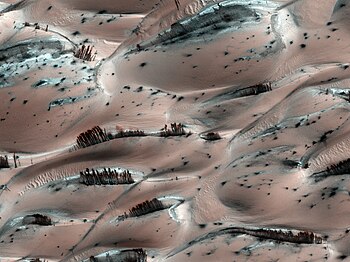
Summary
This is a list of dune fields not on Earth which have been given official names by the International Astronomical Union. Dune fields are named according to the IAU's rules of planetary nomenclature. The relevant descriptor term is undae. As of now, the only two Solar System planets, besides Earth, with named dune fields are Venus and Mars. Dune fields have also been discovered on Saturn's moon Titan,[1] Pluto[2][3] and comet 67P/Churyumov–Gerasimenko.[4]

Venus edit
There are three officially named dune fields on Venus. They are named after desert goddesses, as per the IAU's rules. They are listed below.
Mars edit
There are six officially named dune fields on Mars, which are named after nearby classical albedo features in accordance with the IAU's rules. Five of them lie between 75°N to 85°N, between Planum Boreum and Vastitas Borealis. These dune fields span over 200 degrees of longitude. The sixth, Ogygis Undae, lies on the southern hemisphere of Mars. They are listed below.
Unofficial field names edit
(Curiosity rover; 17 December 2015).
- Bagnold dune field, Gale crater. This dune field was explored by Curiosity between initially between mission Sols ~1174–1248, where the rover investigated High dune, and Namib dune. Three orders of bedform were identified: wind ripple, large ripple (or wind drag ripple[6]) and dune.[7] Sand grains in this section of the dune field had a modal grain size of 120 μm[8]
- Namib dune, Gale crater. This is a prominent feature that looks like the giant dunes of Africa’s Namib Desert.[9]
- As part of the Mars Exploration Rover mission, a small dune field unofficially named El Dorado on the south side of Husband Hill in Gusev crater was investigated by the Spirit rover from sols 706 to 710.[10] Analysis of El Dorado showed that it consists of black wind-blown sand which is "well-sorted, well-rounded and olivine rich.[11]
- The Hagal dune field is named after Frank Herbert's novel Dune and the fictional planet Hagal. The field is also known as the "Martian Morse Code" due to the similarity of the Dune shapes to Morse code dots and dashes.
- Nili Patera dune field
Titan edit
There are five officially named dune fields on Titan, which are named after Greek gods, goddesses or personifications of wind. They are listed below:[12]
- Aura Undae
- Boreas Undae
- Eurus Undae
- Notus Undae
- Zephyrus Undae
Literature also uses names of dark albedo features when referring to Titan's dune fields:
Pluto edit
Analysis of high resolution photos from New Horizons taken on 14 July 2015 of Pluto's Sputnik Planum region in 2018 has confirmed the presence of transverse dunes (perpendicular to the wind streaks) within the cellular nitrogen plains, spaced about 0.4 to 1 km apart, that are thought to be composed of 200-300 μm diameter particles of methane ice believed to be derived from the nearby Al-Idrisi Montes.[2][3] These features are yet to be formally named.
References edit
- ^ "Titan's Seas Are Sand, Cassini's Images Of Saturn's Moon Show". Retrieved 22 April 2021.
- ^ a b Telfer, M.W.; Parteli, E.R.J.; Radebaugh, J.; et al. (1 June 2018). "Dunes on Pluto". Science. 360 (6392): 992–997. Bibcode:2018Sci...360..992T. doi:10.1126/science.aao2975. PMID 29853681.
- ^ a b Hayes, A.G. (1 June 2018). "Dunes across the Solar System". Science. 360 (6392): 960–961. Bibcode:2018Sci...360..960H. doi:10.1126/science.aat7488. PMID 29853671. S2CID 44138724.
- ^ Jia, P.; B. Andreotti; P. Claudin (March 2017). "Giant ripples on comet 67P/Churyumov–Gerasimenko sculpted by sunset thermal wind". Proceedings of the National Academy of Sciences. 114 (10): 2509–2514. arXiv:1703.02592. Bibcode:2017PNAS..114.2509J. doi:10.1073/pnas.1612176114. PMC 5347604. PMID 28223535.
- ^ "USGS Gazetteer of Planetary Nomenclature: Abalos Undae". Retrieved 8 August 2007.
- ^ Lapotre, M. G. A.; Ewing, R. C.; Lamb, M. P.; Fischer, W. W.; Grotzinger, J. P.; Rubin, D. M.; Lewis, K. W.; Ballard, M. J.; Day, M. (1 July 2016). "Large wind ripples on Mars: A record of atmospheric evolution". Science. 353 (6294): 55–58. Bibcode:2016Sci...353...55L. doi:10.1126/science.aaf3206. ISSN 0036-8075. PMID 27365444.
- ^ Ewing, R. C.; Lapotre, M. G. A.; Lewis, K. W.; Day, M.; Stein, N.; Rubin, D. M.; Sullivan, R.; Banham, S.; Lamb, M. P. (2017). "Sedimentary processes of the Bagnold Dunes: Implications for the eolian rock record of Mars". Journal of Geophysical Research: Planets. 122 (12): 2544–2573. Bibcode:2017JGRE..122.2544E. doi:10.1002/2017je005324. ISSN 2169-9097. PMC 5815379. PMID 29497590.
- ^ Ehlmann, B. L.; Edgett, K. S.; Sutter, B.; Achilles, C. N.; Litvak, M. L.; Lapotre, M. G. A.; Sullivan, R.; Fraeman, A. A.; Arvidson, R. E. (2017). "Chemistry, mineralogy, and grain properties at Namib and High dunes, Bagnold dune field, Gale crater, Mars: A synthesis of Curiosity rover observations". Journal of Geophysical Research: Planets. 122 (12): 2510–2543. Bibcode:2017JGRE..122.2510E. doi:10.1002/2017je005267. ISSN 2169-9097. PMC 5815393. PMID 29497589.
- ^ Sandoval, Greg (9 February 2016). "NASA's updated 360-degree view from Mars offers clear look at giant Namib Dune". GeekWire.
- ^ "Mars Exploration Rovers Update: Spirit Descends Husband Hill as Opportunity Works at a Standstill on Olympia". Retrieved 21 November 2006.
- ^ "Recent results from the Spirit rover at Gusev crater" (PDF). Retrieved 21 November 2006.
- ^ "USGS Gazetteer of Planetary Nomenclature: Search: TITAN: Unda, undae". Retrieved 9 December 2018.
- ^ a b c Arnold, K.; J. Radebaugh; C. J. Savage; E.P. Turtle; R.D. Lorenz; E.R. Stofan; A. Le-Gall & the Cassini Radar Team. "Areas of Sand Seas on Titan from Cassini Radar and ISS: Fensal and Aztlan" (PDF). 42nd Lunar and Planetary Science Conference, March 7–11, 2011 at The Woodlands, Texas. LPI Contribution No. 1608. Lunar and Planetary Institute. p. 2804.
- ^ a b Le Gall, A.; M.A. Janssen; L.C. Wye; J. Radebaugh; R.D. Lorenz & the Cassini Radar Team (September 2010). "Regional variations among Titan's dunes: Belet versus Fensal dune fields" (PDF). European Planetary Science Congress 2010 Abstracts. 5: 247. Bibcode:2010epsc.conf..247L.
A large portion of this article was sourced from the Gazetteer of Planetary Nomenclature, the official IAU database of planetary names.
- Ralph Lorenz; James Zimbelman (2014). Dune Worlds: How Wind-blown Sand Shapes Planetary Landscapes. Springer. ISBN 978-3-540-89724-8.


